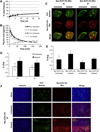A thermally targeted c-Myc inhibitory polypeptide inhibits breast tumor growth
- PMID: 22261328
- PMCID: PMC3536021
- DOI: 10.1016/j.canlet.2011.12.042
A thermally targeted c-Myc inhibitory polypeptide inhibits breast tumor growth
Abstract
Although surgical resection with adjuvant chemotherapy and/or radiotherapy are used to treat breast tumors, normal tissue tolerance, development of metastases, and inherent tumor resistance to radiation or chemotherapy can hinder a successful outcome. We have developed a thermally responsive polypeptide, based on the sequence of Elastin-like polypeptide (ELP), that inhibits breast cancer cell proliferation by blocking the activity of the oncogenic protein c-Myc. Following systemic administration, the ELP - delivered c-Myc inhibitory peptide was targeted to tumors using focused hyperthermia, and significantly reduced tumor growth in an orthotopic mouse model of breast cancer. This work provides a new modality for targeted delivery of a specific oncogene inhibitory peptide, and this strategy may be expanded for delivery of other therapeutic peptides or small molecule drugs.
Copyright © 2012 Elsevier Ireland Ltd. All rights reserved.
Figures





References
-
- Bidwell GL, 3rd, Raucher D. Therapeutic peptides for cancer therapy. Part I – Peptide inhibitors of signal transduction cascades. Expert Opin. Drug Deliv. 2009;6:1033–1047. - PubMed
-
- Raucher D, Moktan S, Massodi I, Bidwell GL., 3rd Therapeutic peptides for cancer therapy. Part II – Cell cycle inhibitory peptides and apoptosis-inducing peptides. Expert Opin. Drug Deliv. 2009;6:1049–1064. - PubMed
-
- Talmadge JE. Pharmacodynamic aspects of peptide administration biological response modifiers. Adv. Drug Deliv. Rev. 1998;33:241–252. - PubMed
-
- Sadler K, Eom KD, Yang JL, Dimitrova Y, Tam JP. Translocating proline-rich peptides from the antimicrobial peptide bactenecin 7. Biochemistry. 2002;41:14150–14157. - PubMed
-
- Bidwell GL, 3rd, Davis AN, Raucher D. Targeting a c-Myc inhibitory polypeptide to specific intracellular compartments using cell penetrating peptides. J. Contr. Release. 2009;135:2–10. - PubMed
Publication types
MeSH terms
Substances
Grants and funding
LinkOut - more resources
Full Text Sources
Other Literature Sources
Medical

